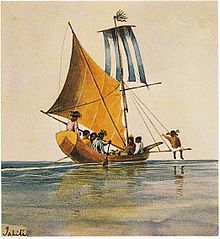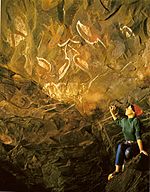
The history of the Pacific Islands covers the history of the islands in the Pacific Ocean.

The history of Oceania includes the history of Australia, Easter Island, Fiji, Hawaii, New Zealand, Papua New Guinea, Western New Guinea, and other Pacific island nations.

The history of Tonga is recorded since the ninth century BC, when seafarers associated with the Lapita diaspora first settled the islands which now make up the Kingdom of Tonga. Along with Fiji and Samoa, the area served as a gateway into the rest of the Pacific region known as Polynesia. Ancient Tongan mythologies recorded by early European explorers report the islands of 'Ata and Tongatapu as the first islands having been hauled to the surface from the deep ocean by Maui.

Polynesian mythology encompasses the oral traditions of the people of Polynesia together with those of the scattered cultures known as the Polynesian outliers. Polynesians speak languages that descend from a language reconstructed as Proto-Polynesian – probably spoken in the Tonga and Samoa area around 1000 BC.
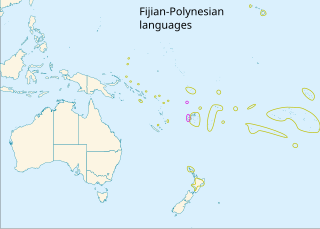
The Polynesian languages form a genealogical group of languages, itself part of the Oceanic branch of the Austronesian family.

Pacific Islanders, Pasifika, Pasefika, Pacificans or rarely Pacificers are the peoples of the Pacific Islands. As an ethnic/racial term, it is used to describe the original peoples—inhabitants and diasporas—of any of the three major subregions of Oceania.
In Polynesian mythology, Hawaiki is the original home of the Polynesians, before dispersal across Polynesia. It also features as the underworld in many Māori stories.
Polynesians are an ethnolinguistic group of closely related ethnic groups who are native to Polynesia, an expansive region of Oceania in the Pacific Ocean. They trace their early prehistoric origins to Island Southeast Asia and form part of the larger Austronesian ethnolinguistic group with an Urheimat in Taiwan. They speak the Polynesian languages, a branch of the Oceanic subfamily of the Austronesian language family. The Indigenous Māori people constitute the largest Polynesian population, followed by Samoans, Native Hawaiians, Tahitians, Tongans and Cook Islands Māori

The Lapita culture is the name given to a Neolithic Austronesian people and their distinct material culture, who settled Island Melanesia via a seaborne migration at around 1600 to 500 BCE. They are believed to have originated from the northern Philippines, either directly, via the Mariana Islands, or both. They were notable for their distinctive geometric designs on dentate-stamped pottery, which closely resemble the pottery recovered from the Nagsabaran archaeological site in northern Luzon. The Lapita intermarried with the Papuan populations to various degrees, and are the direct ancestors of the Austronesian peoples of Polynesia, eastern Micronesia, and Island Melanesia.
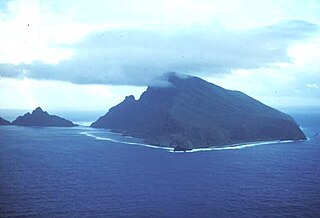
The Samoan Islands are an archipelago covering 3,030 km2 (1,170 sq mi) in the central South Pacific, forming part of Polynesia and of the wider region of Oceania. Administratively, the archipelago comprises all of the Independent State of Samoa and most of American Samoa. The land masses of the two Samoan jurisdictions are separated by 64 km (40 mi) of ocean at their closest points.

The Polynesian Triangle is a region of the Pacific Ocean with three island groups at its corners: Hawaii, Easter Island and New Zealand (Aotearoa). It is often used as a simple way to define Polynesia.

Samoans or Samoan people are the indigenous Polynesian people of the Samoan Islands, an archipelago in Polynesia, who speak the Samoan language. The group's home islands are politically and geographically divided between the Independent State of Samoa and American Samoa, an unincorporated territory of the United States of America. Though divided by national border, the culture and language are the same.
The indigenous peoples of Oceania are Aboriginal Australians, Papuans, and Austronesians. These indigenous peoples have a historical continuity with pre-colonial societies that developed on their territories. With the notable exceptions of Australia, New Zealand, Hawaii, New Caledonia, Guam, and Northern Mariana Islands, indigenous peoples make up the majority of the populations of Oceania.

Oceanic art or Oceanian art comprises the creative works made by the native people of the Pacific Islands and Australia, including areas as far apart as Hawaii and Easter Island. Specifically it comprises the works of the two groups of people who settled the area, though during two different periods. They would in time however, come to interact and together reach even more remote islands. The area is often broken down into four separate regions: Micronesia, Melanesia, Polynesia and Australia. Australia, along with interior Melanesia (Papua), are populated by descendants of the first waves of human migrations into the region by Australo-Melanesians. Micronesia, Island Melanesia, and Polynesia, on the other hand, are descendants of later Austronesian voyagers who intermixed with native Australo-Melanesians; mostly via the Neolithic Lapita culture. All of the regions in later times would be greatly affected by western influence and colonization. In more recent times, the people of Oceania have found a greater appreciation of their region's artistic heritage.

Polynesian navigation or Polynesian wayfinding, which was relearned through Micronesians, was used for thousands of years to enable long voyages across thousands of kilometres of the open Pacific Ocean. Polynesians made contact with nearly every island within the vast Polynesian Triangle, using outrigger canoes or double-hulled canoes. The double-hulled canoes were two large hulls, equal in length, and lashed side by side. The space between the paralleled canoes allowed for storage of food, hunting materials, and nets when embarking on long voyages. Polynesian navigators used wayfinding techniques such as the navigation by the stars, and observations of birds, ocean swells, and wind patterns, and relied on a large body of knowledge from oral tradition. This island hopping was a solution against the scarcity of useful resources, such as food, wood, water, and available land, on the small islands in the Pacific Ocean. When an island’s required resources for human survival began to run low, the island's inhabitants used their maritime navigation skills and set sail for a new island full of possibilities. However, as an increasing number of islands in the South Pacific became occupied, and citizenship and national borders became of international importance, this was no longer possible. People thus became trapped on islands with the inability to support them.

Roger Curtis Green was an American-born, New Zealand-based archaeologist, professor emeritus at The University of Auckland, and member of the National Academy of Sciences and Royal Society of New Zealand. He was awarded the Hector and Marsden Medals and was an Officer of the New Zealand Order of Merit for his contributions to the study of Pacific culture history.

Polynesia is a subregion of Oceania, made up of more than 1,000 islands scattered over the central and southern Pacific Ocean. The indigenous people who inhabit the islands of Polynesia are called Polynesians. They have many things in common, including language relatedness, cultural practices, and traditional beliefs. In centuries past, they had a strong shared tradition of sailing and using stars to navigate at night.
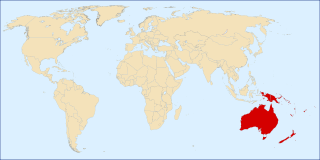
The following outline is provided as an overview and topical guide to Oceania.

The Polynesian Leaders Group (PLG) is an international governmental cooperation group bringing together four independent countries and eight self-governing territories in Polynesia.

Oceanian culture encompasses the collective and diverse customs and traditions of art, architecture, music, literature, lifestyle, philosophy, politics and religion that have been practiced and maintained by the many ethnic groups of the geographical region of Oceania since prehistory. Cultures of Oceania reflect not only that of the region's indigenous peoples, but also the cultures brought by European colonisation and the United States, particularly through mass culture such as cinema and TV. Oceania is commonly divided into four geographic sub-regions, characterized by shared cultural, religious, linguistic, and ethnic traits: Australasia, Melanesia, Micronesia, and Polynesia. Most Oceanian countries are multi-party representative parliamentary democracies, and tourism is a large source of income for the Pacific Islands nations.

